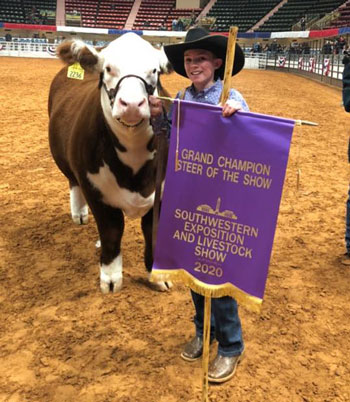I enjoyed a delicious steak the other night, courtesy of some rancher who raises Wagyu cattle here in Texas. Without a doubt it was superior, but the price does not allow it to be daily or even monthly fare on the menu at the Taylor home. Yet, I also felt very guilty enjoying such a meal. You see, my family have been Hereford cattle raisers since the late 1880s.

(photo courtesy of Fort Worth Stock Show and Rodeo)
Back in February I saw on television that a young man from Meadow, Texas, and his steer he calls Cupid Shuffle, had won the Grand Champion Steer at the Fort Worth Stock Show and Rodeo. At the sale, the steer brought a record $300,000 price. The young man, Ryder Day, lives on the ranch where Cupid Shuffle was bred and born. He has raised and showed several steers, but this was the winner.
When asked what he intended to do with the prize money, he said he was planning to use most of the money for college. That may be a problem in the family household. His mother is a Texas Tech graduate while his father is an Aggie. Asked what he liked to do most, he replied work on the ranch. A true Texas cattleman.
Why was this so exciting? For those of you who are not familiar with the cattle business, there are two primary breeds of beef cattle, Herefords and Angus. For years Herefords were favorites. Imported from Great Britain over 200 years ago, the Hereford acclimated easily to our summer heat. It’s a docile animal, with a long lifetime and easy to spot in a pasture. Herefords are the red cows with white faces and white on lower legs. Early in the 20th century, ranchers began to dehorn their livestock. Today, they are naturally polled, with no horns.
However, you may be familiar with Angus cattle. The Angus Breeders’ Association has done an unbelievable campaign to convince Americans that Angus cattle are the best. Grocery stores flaunt the name Angus on their beef, as do restaurants. In my biased opinion, I believe both types of beef are equal if they have been raised and fed right.
For years, I always heard that Angus could not survive Texas heat, but their numbers grew. My great-grandfather bought a Hereford bull from the Isaac Ranch in Clay County around 1889. His ranch was in Montague County, just to the east. For years, Jeff Seay and two of his sons, bred Herefords. In 1912, my grandfather Virgil Seay, his brother Hardy Seay, and two cowboys walked a herd of fifty impregnated heifers from Montague County to the west part of Archer County. The other three men went back to Montague County, but my grandfather spent the rest of his life on what he called “the place.”
My brother raised steers and showed at the Fort Worth Stock Show and Rodeo while in high school. Every year when it was time to go to Fort Worth, there was bad weather. Many a time he drove over icy roads with his steer in the trailer.
The last Hereford steer to win Grand Champion was in 1982. It was a long dry streak before young Ryder Day and Cupid Shuffle took the honors. In addition to those two, the Reserve Champion this year was a girl who raised a Hereford. Things appear to be changing.
